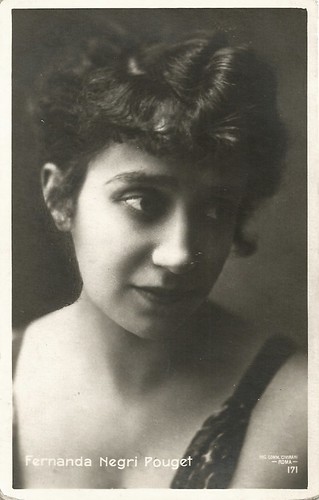
Italian postcard by Ed. Vettori, Bologna, no. 171. Photo: Comm. Civirani, Roma.
Fernanda Negri Pouget (1889-1955) was an Italian actress who starred in the Italian silent cinema of the 1910s.

Italian postcard by Ed. Vettori, Bologna, no. 215. Photo: Civirani, Roma.
Amleto Novelli (1885-1924) was a famous actor in Italian silent cinema, as well in epic and historical cinema as in diva films.
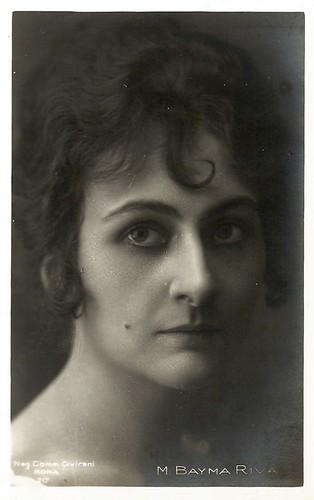
Italian postcard by Ed. Vettori, Bologna, no. 217. Photo: Civirani, Roma.
Mary Bayma-Riva (?-?) was an actress of Italian silent cinema of the 1910s and early 1920s, acting at companies such as Gloria and Floreal Film in films like Florette et Patapon (1913) and Il pastor fido (1918).
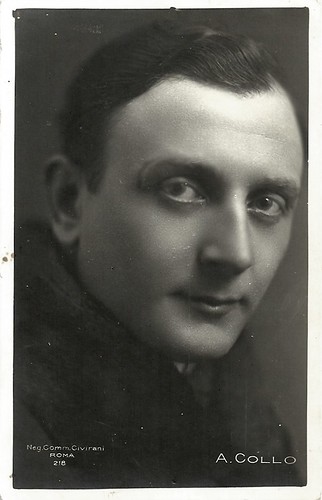
Italian postcard by Ed. Vettori, Bologna, no. 218. Photo: Comm. Civirani, Roma.
Alberto Collo (1883-1955) was an Italian film actor of mostly silent cinema. In the 1910s and early 1920s, he acted opposite the female stars of his times, such as Francesca Bertini, Hesperia, Maria and Diomira Jacobini and Italia Almirante Manzini. He also performed in war propaganda, historical films and strong men films.
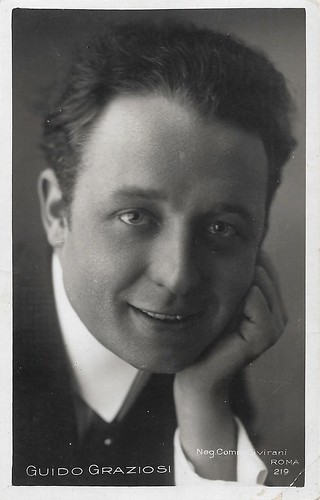
Italian postcard by Ed. Vettori, Bologna, no. 219. Photo: Comm. Civirani, Roma.
Guido Graziosi (?-?) was a prominent stage actor within the company of Ermete Zacconi In 1912, he started his film career at the Turin-based company Savoia. He acted in films with a young Maria Jacobini and with the French actress Stacia Napierkowska.
Carlo and Osvaldo Civirani
'Commendatore' Carlo Civirani had a well-frequented photo studio in Via Nazionale 22 in Rome. He was an acclaimed distinguished photographer, his son told in an interview, wearing a redingote and a monocle. Carlo Civirani belonged to the group of Roman studio photographers which also included Pinto, Villoresi and d'Alessandri.
Carlo's son Osvaldo Civirani learned photo retouching from his father and did this also for the other Roman photographers. In 1934 on the recommendation of his father, Osvaldo Civirani would start at the photo studio of Aurelio Pesce at the Cines Pittaluga film studio complex in Via Veio.
In 1935 he would make his first set photos, becoming one of Italy's most notable still photographers. In 1943, being hired as a still photographer on the set of Luchino Visconti's Ossessione/Obsession (1943), Civirani introduced the novelty of taking pictures, not after the scene was shot - in a constellation that was staged for this purpose -, but while the scene was being shot, using for that purpose the lighter and unobtrusive Plaubel Makina 3. According to Civirani, this was also the first time that the still photographer appeared in the title credits.
As a set photographer, he worked with other famous film directors such as Alessandro Blasetti on Fabiola/The Fighting Gladiator (1949), Roberto Rossellini on Francesco, giullare di Dio/The Flowers of St. Francis (1950), Federico Fellini on Lo sceicco bianco/The White Sheik (1952), and Carlo Lizzani on Cronache di poveri amanti/Chronicle of Poor Lovers (1954).
Until 1963, Civirani worked mainly as a still photographer on over two hundred films. From 1963 to 1976, Osvaldo Civirani would also produce and direct 20 films in various genres: Peplum, Euro-Spy films, Spaghetti Westerns, and comedies with Franco & Ciccio. He later wrote two books: 'Un fotografo a Cinecittà' and 'La donna dei sogni', in which Civirani collected the memories and experiences of a whole life dedicated to cinema.
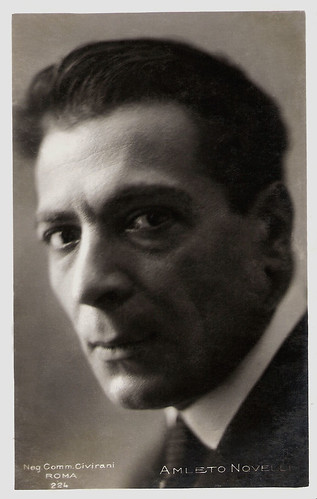
Italian postcard by Ed. Vettori, Bologna, no. 224. Photo: Comm. Civirani, Roma.
Amleto Novelli (1885-1924) was a famous actor in Italian silent cinema, as well as in epic and historical cinema as in diva films.
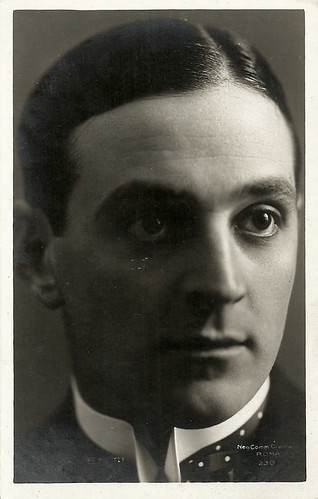
Italian postcard by Ed. Vettori, Bologna, no. 230. Photo: Civirani, Roma.
Luigi Serventi (1885-1976), was a male star of Italian silent cinema, often cast with Italian divas such as Pina Menichelli. After his Italian career, he continued in Germany and Czechoslovakia in the 1920s.
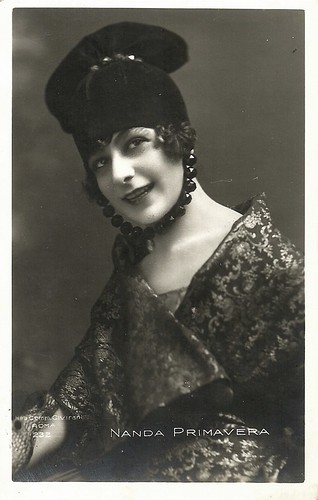
Italian postcard by Ed. Vettori, Bologna, no. 232. Photo: Civirani, Roma.
Nanda Primavera (1898-1995), was an Italian actress and singer. From 1940 on, she appeared in several Italian films.

Italian postcard by Ed. Vettori, Bologna, no. 241. Photo: Comm. Civirani, Roma.
Amleto Novelli (1885-1924) was a star actor in Italian silent cinema. He appeared in many biblical films and epics and starred with all the divas of the Italian film. During the shooting of a film, he suddenly died, only 38.

Italian postcard by Ed. Vettori, Bologna, no. 317. Photo: Comm. Civirani, Roma.
Olga Benetti (?-1958) was an Italian actress who acted in many films of the Roman film companies Cines, Celio, and Caesar in the 1910s and early 1920s. She often performed opposite Francesca Bertini, Gustavo Serena, and her husband Carlo Benetti (1885-1949).

Italian postcard by Ed. Traldi, Milano, no. 39. Photo: Civirani, Roma.
Alberto Collo (1883-1955) was an Italian film actor of mostly silent cinema. In the 1910s and early 1920s, he acted opposite the female stars of his times, such as Francesca Bertini, Hesperia, Maria and Diomira Jacobini and Italia Almirante Manzini. He also performed in war propaganda, historical films and strong men films.

German Postcard by Film-Foto-Verlag, no. A3784/1, 1941-1944. Photo: Civirani.
Classic beauty Anneliese Uhlig (1918) was an elegant and enchanting femme fatale of Ufa crime films of the 1940s, who unwillingly bewitched Joseph Goebbels and hat to move to Italy. After the war, the German actress worked also internationally as a journalist, theatre producer and university teacher and became an American citizen.
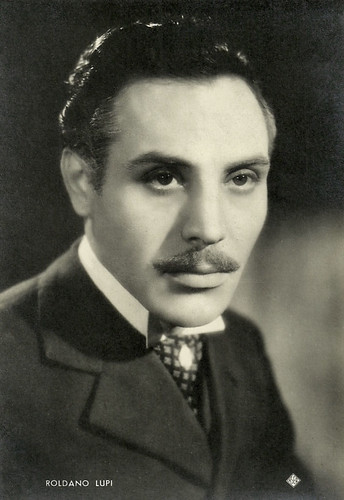
Italian postcard by ASER (A. Scaramaglia Edizioni Roma), no. 353. Photo: Civirani / Lux Film.
Roldano Lupi (1909-1989) was an Italian actor in cinema, television and theatre.
Sources: Wikipedia (English and Italian) and IMDb.
No comments:
Post a Comment